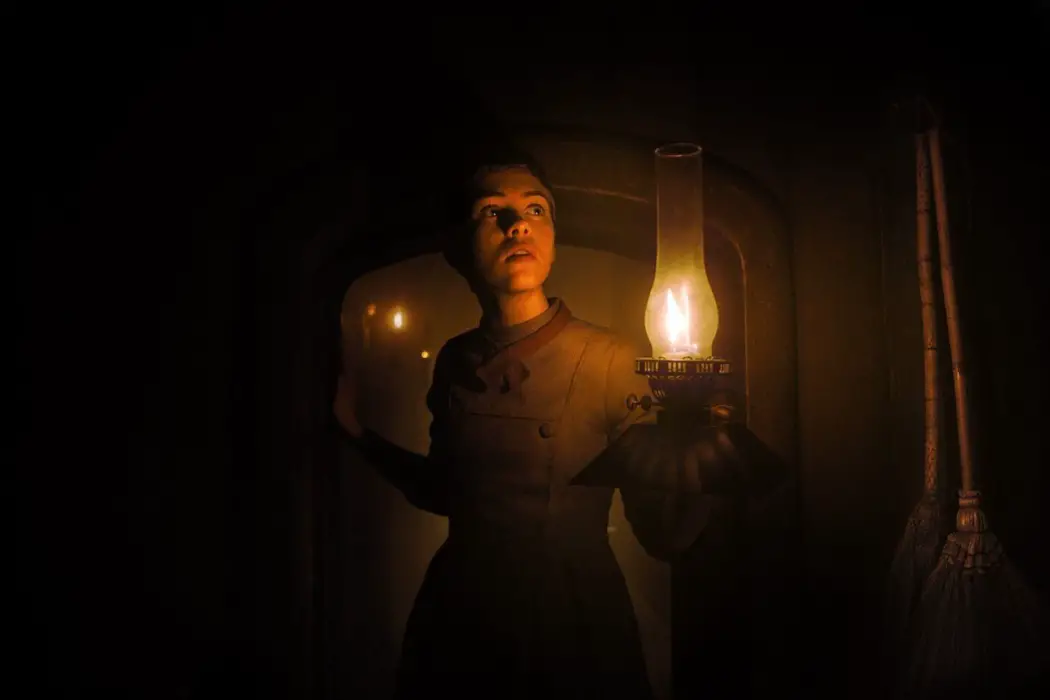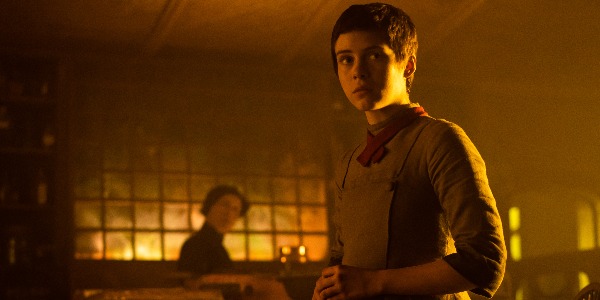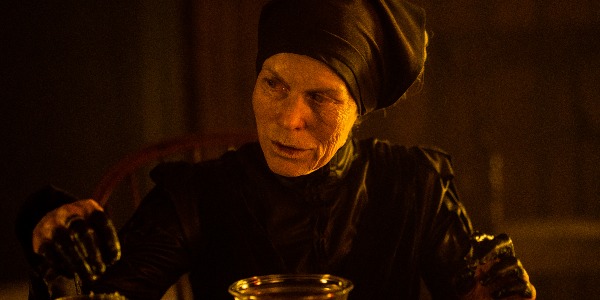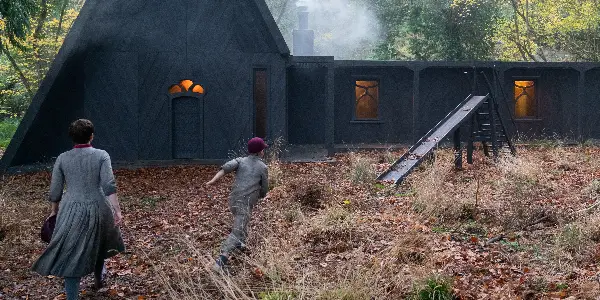GRETEL & HANSEL: Unique, Stylish & Muddled Remix Of A Classic Fable

I'm a student at the University of North Carolina at…
Regardless of the merits of his individual films, director Osgood Perkins has an undeniably impressive control of atmosphere and mood, a keen eye for compelling compositions and visual flair that makes his work immediately noticeable. Tentatively, I’d even put his work under the umbrella of so-called “elevated horror,” the new school of art-house chillers defined by filmmakers like Robert Eggers and Ari Aster. Perkins‘ films feel scary before anything scary has even happened. The Blackcoat’s Daughter, the director’s 2015 debut, is rarely a tour de force of thrills and chills, instead preferring to maintain an icy, threatening ambiance that occasionally slips into vicious carnage. However, its greatest asset is also its most notable shortcoming: it’s too reliant on atmospherics and vagueness, often to the detriment of the story at hand.
Perkins‘ third feature, Gretel & Hansel, finds the filmmaker in similar thematic and formal territory; predictably, the results are similarly mixed. Here, the filmmaker remixes the iconic fairy tale into a coming-of-age story of female empowerment and societal constraints on gender and sexuality, which makes the comparisons to Eggers‘ The Witch practically inevitable. Though it comes with a darkly colorful modern flair, Perkins seems to invite the comparison to his contemporary’s much-discussed debut: the film’s rustic aesthetic, coupled with its attempt at period-accurate dialogue, certainly doesn’t hide its primary influence.
But if The Witch felt both precise and frightening in its evocation of folklore and the American history of witchcraft, Gretel & Hansel is thematically muddled and sluggish, often relying on the splendid production design and score to push things along. It’s easy to see what it’s trying to accomplish, but the end result feels both disappointing and a tad derivative.
Lost in the Woods
It’s been a fair bit of time since I read the actual Grimm fairy tale version of Hansel & Gretel, but I remember the basics, and it’s really all you need to know going into Perkins‘ take (especially considering how much is a revision from the original version). Of course, this version takes the crucial step of making Sophia Lillis‘ Gretel the central character, privileging her psychology and growth as a young woman in the harsh, pre-modern pastoral era. Hansel (Sammy Leakey) is a major figure, of course, but he’s mostly dead weight as his sister wanders the woods — a fact that becomes a core aspect of the narrative conflict. Gretel’s even the source of the film’s voiceover, a choice that also becomes somewhat ham-fisted as the story continues.

However, the film does not actually begin with the story of our famous duo. Instead, we hear a dark tale of a young girl, whose father turns to a dark and malevolent spirit to cure her of an affliction. She’s cured, but it comes at a price, as she’s touched with powers that are quickly used for evil. She’s banished to the woods, with her pointy hat becoming a source of anguish for all to fear.
After this prologue, we meet Gretel, who has been tasked by her mother with finding a job to provide for the family. When she fails in her interview with a powerful local man — he’s more interested in whether she has remained “pure” than her abilities as a worker — Gretel’s mother sends her and Hansel away. Wandering the woods with nothing to eat (they eventually stumble upon some magic mushrooms — guess this is an elevated horror staple now), they eventually stumble upon a house with everything a starving boy and girl could dream of: cakes, fruit, delicious ham, and more. The house is maintained by an enigmatic old woman (Alice Krige), whose blackened fingers and frightening demeanor immediately put Gretel on high alert.
Gloomy Atmosphere Highlights Stunning Technical Work
But if you’re expecting the traditional version of this tale — Hansel and Gretel get fattened up, the old woman tries to eat them, etc. — you’re in for a surprise. The witch has something to offer Gretel — a path to powers only possible in her wildest dreams. But we’ll get to that in a second. Gretel & Hansel is much more robust with strong ideas than Perkins‘ debut feature (a creepy film that nonetheless feels curiously thin), but it once again prioritizes unusual and striking visuals over anything truly complex or cohesive from a narrative perspective. It’s all about the moody, low-key sense of doom-and-gloom that permeates Gretel and Hansel’s entire journey.

Perkins specializes in a particular kind of atmospheric horror, in which characters speak in hushed and frightened whispers, creating a kind of contradictory minimalism that seems to both invite the presence of something horrific and dispel the very terror we all know is coming. His camera is often fixed and stable — dynamic movement is rare and unimportant, with the painterly frames taking absolute precedence; it’s an impressive, rigorously controlled style of filmmaking. However, it’s clear that Perkins is attempting to expand his toolbox a bit here. Handheld shots of Gretel provide a stark contrast to the uncomfortable stillness of his frames; it’s also evident that this film is much more interested in its principal characters than Blackcoat’s Daughter ever was.
But even if Perkins attempts to do something a little different in this PG-13 film — there are no brutal decapitations or vicious stabbings in this film — his adept ability at creating a very specific, easily identifiable vibe still dominates. It’s dead serious, meticulous, and, mercifully, tightly wound to an impressive degree (more 87 minute-long mainstream horror, please).
Late Twists & Sluggish Pace Muddle Compelling Concept
If Gretel & Hansel were merely an off-kilter mood piece, it might be a bit more successful. The director’s films still lack any sense of levity or humor, but that’s somewhat forgivable in the face of the film’s goals. What’s less forgivable is the script, which feels like a non-starter in a number of regards. The Blackcoat’s Daughter was written by Perkins himself, and it was both inventive and overwritten; ambitious structurally, though still reliant on a “gotcha!” twist that felt relatively obvious. I was initially surprised to learn that Perkins wasn’t the writer for this project, but in retrospect, it’s actually not all that shocking. Rob Hayes is the screenwriter here, and while it always feels somewhat cruel to point to a debut screenwriter as the problem with a film, this script does represent some of the most glaring missteps of the whole endeavor.

That’s not to say that Hayes‘ script is entirely without merit. The feminist angle on the classic fable is fruitful, and the film’s method of putting a Freudian psychosexual spin on witchcraft is both brutally obvious and a little surprising. At times, Gretel & Hansel has more in common with the latest Star Wars trilogy than it does with its horror contemporaries, which is arguably when it’s at its most compelling. The film pivots on its axis entirely once this angle is revealed; what initially feels familiar and rote begins to enter genuinely unfamiliar territory.
But as unique as it can be, Gretel & Hansel stumbles in many other areas. The film is perpetually stuck between attempting to modernize the tale and opting to situate it in an archaic context, halfway featuring the kind of old-fashioned dialogue patterns re-popularized by Eggers and his team. Yet the film’s stars, especially Sophia Lillis, struggle to make the dialogue exchanges feel naturalistic rather than stilted or phony, tripping on a tightrope that is always in play when you bring it that gimmick. Most crucially, the film’s reliance on Gretel’s subjectivity is intriguing until the moment it becomes overwrought, relying on expository voiceover narration and shock moments instead of offering any level of ambiguity. There’s an eventual lack of intrigue to the proceedings, no matter how hard Perkins uses his technical acumen to try to make things frightening.
Gretel & Hansel: Conclusion
I won’t try to suggest that Gretel & Hansel is an uninteresting film, but it’s certainly an unsatisfying one. It’s conceptually a clever spin on a story we all know, but when that spin fails at generating scares or digging up much in the way of completely novel insight, it’s hard to know what to get out of the experience. Perkins remains a talented and enigmatic voice on the horror scene, and I look forward to seeing him really knock one out of the park in the near future. For now, his latest falls just shy of the mark.
What did you think of Gretel & Hansel? Are you a fan of director Osgood Perkins’ other films? Let us know in the comments below!
Gretel & Hansel was released in the US on January 31, 2020. For a full list of international release dates, click here.
Does content like this matter to you?
Become a Member and support film journalism. Unlock access to all of Film Inquiry`s great articles. Join a community of like-minded readers who are passionate about cinema - get access to our private members Network, give back to independent filmmakers, and more.
I'm a student at the University of North Carolina at Chapel Hill. For 8 years, I've edited the blog Martin on Movies. This is where I review new releases, cover new trailers, and discuss important news in the entertainment industry. Some of my favorite movies- Casablanca, Inception, Singin' in the Rain, 2001: A Space Odyssey, The Wolf of Wall Street, The Nice Guys, La La Land, Airplane!, Skyfall, Raiders of the Lost Ark. You can find my other reviews and articles at Martin on Movies (http://martinonmovies.blogspot.com/).













